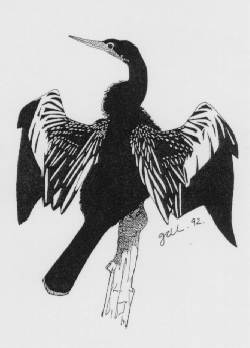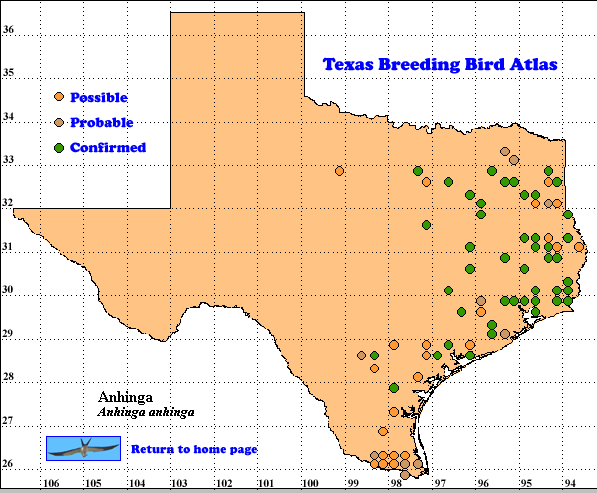Anhinga anhinga
The Anhinga is the classic bird many people visualize when they think of a swamp; a place of Spanish moss draped trees in a watery environment. It is a bird that is frequently seen sunning itself on a snag with wings spread and long neck outstretched. Its behavior of frequently bobbing its neck and making primitive calls adds to the mystique of its setting. The Anhinga, also known as “water turkey” and “snake bird”, breeds in the freshwater river bottoms and swamps of the southeastern United States southward to northern Argentina and Uruguay (American Ornithologists’ Union 1998).
In Texas, Anhingas forage and breed in swamps which are frequently dominated by bald cypress. Typical sites include Caddo Lake (32o 45′ N, 94o 00′ W), below Sam Rayburn Reservoir in the “forks of the river” (30o 45′ N, 94o 10′ W), the “blue elbow swamp” of Orange County (300 10′ N, 93o 45’W), and in the Trinity River delta near Wallisville (29o 50′ N, 94o 45′ W). They also nest in river and creek oxbow lakes and sloughs, beaver ponds, and the upper ends of reservoirs where substantial numbers of trees still exist in the water.
DISTRIBUTION: Oberholser (1974) reported the Anhinga as occurring in most Texas river bottoms south and east of the Edwards Plateau and Dallas. Greatest concentrations occur in swamps, typically towards the delta of the rivers. TBBAP atlasers most frequently reported confirmed nesting along the Sulphur, Sabine, Neches, Trinity and Brazos Rivers (all in the eastern third of the state north of 29 degrees latitude), and two reports each on the Guadalupe (28097 and 28096) and Nueces River (27097 and 28098) drainages.
SEASONAL OCCURRENCE: The Anhinga occurs throughout the breeding season in low numbers in suitable swamp-like/oxbow habitats. During spring and fall there is an abundance of Anhingas as many thousands of birds from states to the east and local residents are observed migrating through Texas along river valleys and the coast “to and from” breeding grounds and their winter homes. They can frequently be observed soaring in kettles along with hawks, vultures and other raptors. Anhingas start forming large flocks in August and migrate southward along rivers to the upland side of the coast and then paralleling the coast southward throughout the months of August and September. Anhingas reverse their migration route in March and April. Nesting usually starts in April and May and ends in August (Oberholser 1974). TBBAP atlasers reported confirmed nesting from 29 May through 17 July. Small numbers commonly over-winter in swamps and other forested wetlands along the coast and inland as far north as Jasper. This species seeks sunlit, wind protected openings during the cooler months at these sites because of the water soaking tendencies of Anhinga feathers (Owre 1967).
BREEDING HABITAT: The Anhinga is colonial and typically nests in small aggregations along with much larger numbers of herons, egrets, ibises and cormorants. Nests are relatively bulky, made up of sticks and other vegetation, and situated in a fork within the canopy of live trees. The nesting colony is almost always located over water. A similar appearing species, the Neotropic Cormorant (Phalacrocorax olivaceus), almost always positions its nests to the outside of the canopy or the highest point of trees. Many times the nests are located on dead snags. Anhinga colony sites are most frequently in swamps and other forested wetlands.
STATUS: Populations of Anhingas are expected to have declined during this century when over half of the Texas bottomland hardwood forests were lost due to reservoir construction and land use changes (Frye 1987). However, large scale surveys of birds were only conducted after much of the land use changes have already occurred. They show that this species occurs in small numbers over a broad area, but no accurate population trends are available.
The Texas Colonial Waterbird Society annually surveyed inland and coastal colonial waterbird sites from 1973 to the present at sites that were accessible to observers, with most inland sites being dropped from the survey after the 1980s. Anhingas only represented a small portion of the birds surveyed in these colonies. No reliable trend data was obtained from these surveys because Anhinga nests are scattered amongst hundreds of other heron/egret/ibis nests and are generally out of view within the canopy of trees. One of the largest concentrations reported during the surveys was 350 pairs at the Beaver-Catfish Club (31o52′ N, 95o53’W) in 1979 in Anderson County (Texas Colonial Waterbird Society 1982). Typical sites where Anhingas nested were reported to have fewer than 50 pairs.
The federal breeding bird surveys conducted along roadways since 1968 in Texas do not contact enough swamp habitat to adequately survey this species. An adequate sample for statistical trend analysis typically requires a species to be found on at least 14 routes. Anhingas are normally found on less than 5 routes each year (B. Peterjohn pers. comm.).
The TBBAP did not show any appreciable change from the status at the time of Oberholser’s (1974) landmark book on the birds of Texas with exceptions in extreme eastern Texas where few birders reported observations. Oberholser (1974) only showed one nesting record along the Sabine and Neches River drainages, but this was an artifact owing to few birders reporting from the area and not from a lack of birds. The TBBAP reported 18 quads with confirmed nesting in these two drainages. Otherwise, TBBAP atlasers reported confirmed and probable breeding evidence from traditional nesting areas.
Text by Brent Ortego (ca. 1999)
Literature Cited
American Ornithologists’ Union. 1998. Check-list of North American Birds. 7thed. Am. Ornithol.’Union, Washington, DC.
Frye, R. G. 1987. Bottonland hardwoods – current supply, status, habitat quality and future impacts from reservoirs. pp. 24-28 In Bottomland hardwoods in Texas ( C. A. McMahan and R. G. Frye eds).. Texas Parks Wildl. Dept. PWD-RP-7100-133-3/87.
Oberholser, H. C. 1974. The bird life of Texas. University of Texas Press, Austin.
Owre, O. T. 1967. Adaptations for locomotion and feeding in the Anhinga and the Double-crested Cormorant. Ornithol. Monogr. 6.
Texas Colonial Waterbird Soc. 1982. An Atlas and Census of Texas Waterbird Colonies 1973-1980. Caesar Kleberg Wildl. Res. Instit., Kingsville.

